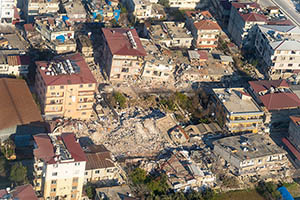Turkey up against earthquakes
 6 February 2023, a date that will forever mark Turkey. In an extremely rare occurrence, the natural disaster consisting of two separate tremors, spaced a few hours apart, became the worst natural catastrophe to hit the region in over a century.
6 February 2023, a date that will forever mark Turkey. In an extremely rare occurrence, the natural disaster consisting of two separate tremors, spaced a few hours apart, became the worst natural catastrophe to hit the region in over a century.
The first earthquake of magnitude 7.8, which occurred at 4:17 am local time, was the deadliest event of its kind in the world since the 2020s. The second one, of magnitude 7.5 located 95 kilometers from the first, occurred at 10:24 am.
These two powerful earthquakes have left behind a very heavy human toll estimated at 48 448 dead and hundreds of thousands injured.
In March 2023, the material damage was estimated at nearly 100 billion USD.
Read also | Earthquake in Turkey: economic consequences
Turkey, land of earthquakes
Turkey is located on two main seismic faults. One, the North Anatolian Fault (with two major earthquakes in 1939 and 1999), located in the north of the country while the second, the East Anatolian Fault, is located in the southeast.
Situated at the crossroads of three tectonic plates, African, Arabian and Eurasian, the Turkish tectonic micro plate periodically undergoes violent movements. With pressure piling up, the plates end up releasing an enormous amount of energy triggering strong earthquakes.
The first earthquake of 6 February, which occurred on the East-Anatolian fault, is characterized by:
- its powerful intensity,
- its low depth of 18 kilometers under the surface of the earth,
- the occurrence, a few hours later, of a second strong earthquake of similar magnitude,
- the extension of the aftershock zone over several hundred kilometers,
- the recording of more than 7 500 aftershocks since 6 February along the Anatolian fault.
According to the U.S. Geological Survey (USGS), the powerful earthquake in Turkey created a fault nearly 200 km long and about 25 km deep with the displacement of the region of about three meters to the southwest.
The most powerful earthquakes in Turkey since 1900
| Date | Place | Magnitude | Number of deaths | Number of injuries |
|---|---|---|---|---|
| 6 February 2023 | Turkey, Syria | 7.8 and 7.5 | +50 000 | +100 000 |
| April 2022 | Pütürge, Malatya Province | 5.2 | - | - |
| November 2022 | Goyaka, Duzce | 5.9 | 2 | 93 |
| January 2020 | Elazig, Izmir | 6.8 | 117 | 1600 |
| October 2020 | Aegean Sea | 6.6 | 24 | 1053 |
| June 2017 | Aegean Sea | 6.3 | 2 | 480 |
| October 2011 | Van | 7.2 | 604 | 4152 |
| March 2010 | Basyust, Elazig | 6 | 42 | 74 |
| August 1999 | Izmit, Marmara | 7.6 | 17 000 | 43 000 |
Earthquake of 6 February 2023 in Turkey: apocalyptic landscapes
Shaken on 6 February 2023 by the devastating double tremor and by the numerous aftershocks, entire buildings collapsed like houses of cards. In Turkey alone, cities such as Antakya were completely razed to the ground while others were very heavily affected: Hatay, Adiyaman, Gaziantep, Kahramanmaras, Adana, Malatya, Kilis, Islahiye, ...
The scale and extent of the damage is striking with entire neighborhoods ravaged, more than 160 000 buildings collapsed or severely damaged, roads gutted, infrastructure destroyed, railroad lines cut, fields cracked, …
Because of the time of the first tremor, the human toll was very heavy. Seized in the middle of their sleep, the inhabitants did not have time to react and evacuate their homes.
According to a last count dated 24 February 2023, the number of dead people exceeded the 50 000 marks, including more than 44 000 on Turkish soil. According to the United Nations, which fears a large-scale humanitarian crisis, this provisional figure could even be doubled.
In addition to the large number of deaths, there are more than 100 000 missing and hundreds of thousands injured. The number of homeless Turks and Syrians is in the millions.
This heavy and dramatic toll is not only due to the natural disaster but also to the poor quality of the buildings, the inobservance of the anti-seismic construction standards and the lack of control by the authorities.